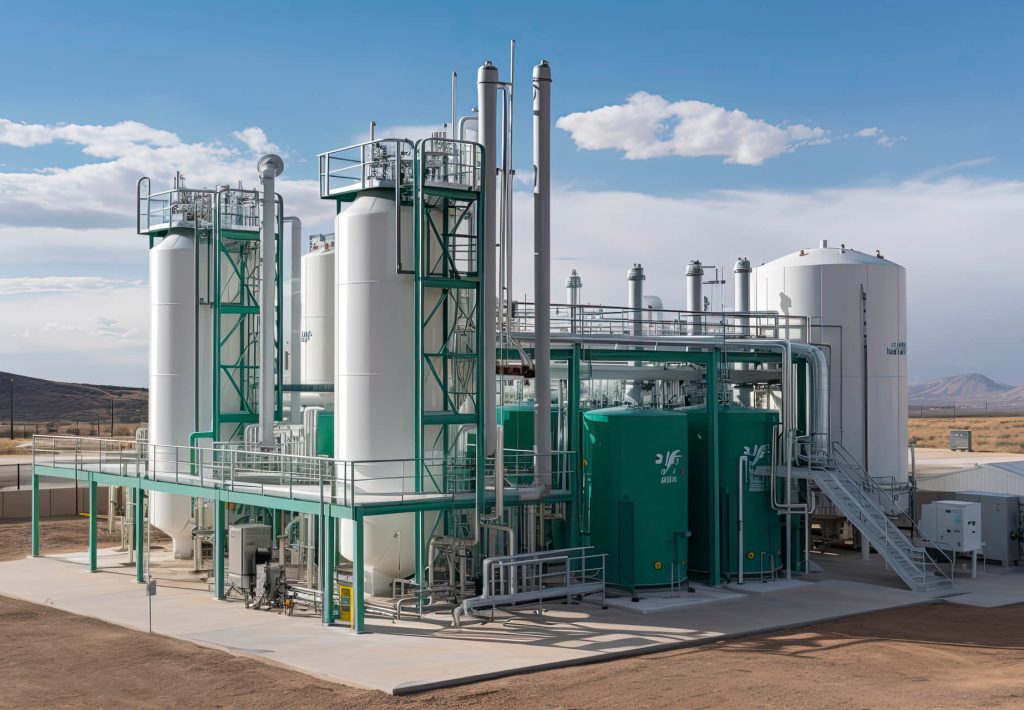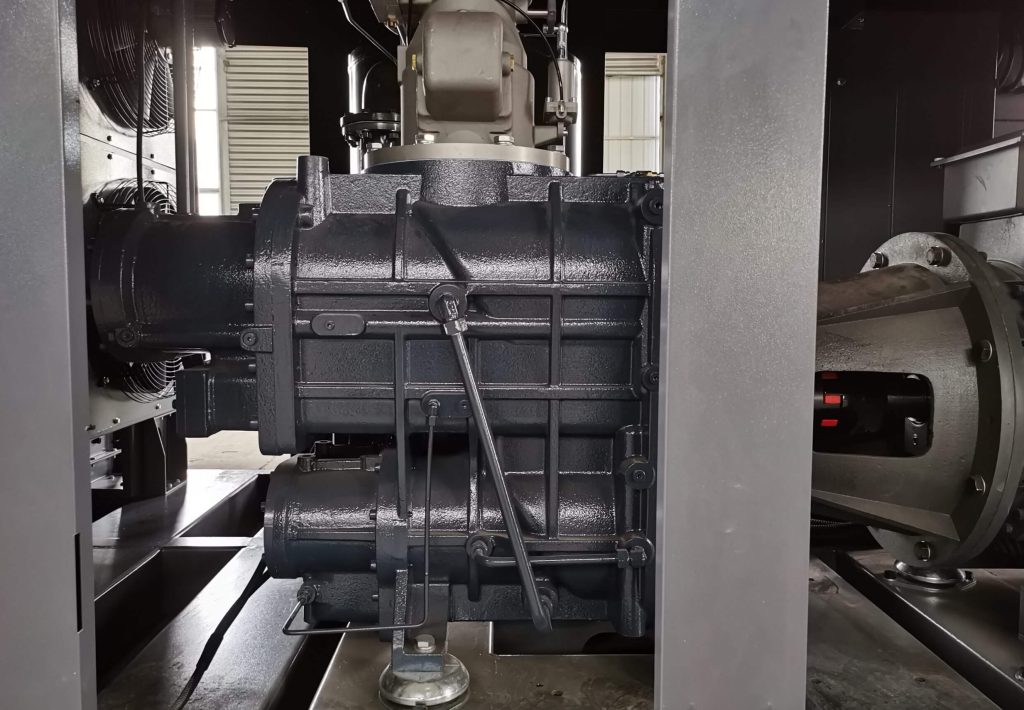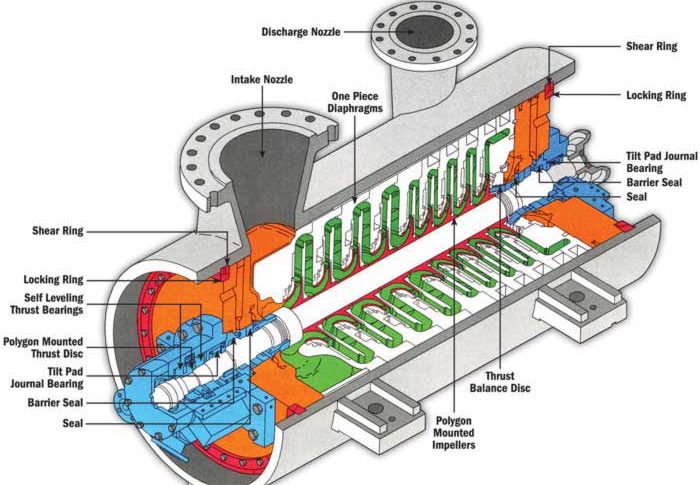A vane compressor is a widely used device in the industrial gas compression field and holds a significant position within the air compressor category. As a leader in the field of precision compression equipment, MINNUO has extensive experience in the design and manufacture of vane compressors. The company provides efficient and stable gas compression solutions tailored to the needs of various industries. This article will delve into the working principle, technical specifications, industry-specific applications of vane compressors, and explain why they have become the ideal compression technology choice for many industrial applications.
A vane compressor uses a rotating rotor and multiple vanes to carry out the gas compression process. The main stages include air intake, gas compression, and gas discharge. Specifically, the rotor is eccentrically mounted within the cylinder, and the vanes on the rotor are pressed against the cylinder wall by centrifugal force or spring force. As the rotor rotates, the vanes maintain good contact with the cylinder wall, compressing the gas to the desired pressure. With its smooth operation and efficient gas compression capabilities, the vane compressor has become an indispensable piece of equipment in many industries.

1. Detailed Technical Explanation:
1.1 Air Intake and Compression
Air is drawn into the compressor through an intake valve. Under the influence of the vanes, the air is gradually compressed within the rotor’s cavity. It is important to note that the statement “each gas molecule is effectively pushed to the center of the compression chamber” is not entirely accurate. Instead, as the rotor rotates, the volume of the enclosed work chamber, formed by the rotor, vanes, and cylinder wall, decreases, thereby compressing the gas.
1.2 Compression and Discharge
As the rotor continues to rotate, the vanes slide along the cavity, and when the compressed air reaches the required pressure, it is discharged through the exhaust valve to the external system. The unique design structure of the vane compressor allows it to operate efficiently and smoothly under high-pressure conditions.
1.3 Stability and Low Vibration
A key feature of the vane compressor is its low vibration. Because the vanes always maintain close contact with the cylinder wall, the vibration and noise generated during compression are significantly reduced. This makes it ideal for applications where noise control is critical. However, compared to screw compressors, vane compressors typically operate at a noise level of 60–85 dB, which is slightly higher than the 55–75 dB noise level of screw compressors. Therefore, a comprehensive evaluation is necessary in practical applications.
2.Types of Vane Compressors
| Type | Typical Flow Rate Range | Pressure Range | Application Scenarios |
| Small Vane | 0.1–5 m³/min | 0.7–1.0 MPa | Laboratories, Small Pneumatic Equipment |
| Medium Vane | 5–30 m³/min | 0.7–1.3 MPa | Industrial Gas Supply, Packaging Machinery |
| Large Vane | 30 m³/min and above | 0.7–2.0 MPa | Chemical, Power Industries |
Regarding gas purity, it is not determined by the compressor model but by the sealing materials and lubrication methods. For example, oil-free vane compressors are suitable for industries with high gas purity requirements, such as medical and food sectors, ensuring gas cleanliness. Oil-injected vane compressors are typically used for general industrial gas compression scenarios. The statement “high-efficiency models are suitable for high-purity gases” from the original text is misleading and may cause confusion.
3. Industry-Specific Applications
3.1 Industrial Gas Compression
Vane compressors are widely used in various industrial gas compression scenarios. Whether for stable gas supply during manufacturing processes or for continuous, high-efficiency air compression in automated production, vane compressors perform efficiently and stably. However, their application in the automotive industry is relatively limited. The automotive sector typically uses piston or scroll compressors, with vane compressors being used only in specific scenarios, such as certain air conditioning compressors. In heavy industries, they are more commonly seen in chemical, metallurgical, and wastewater treatment applications, such as in transporting gas or biogas.
3.2 Precision Gas Compression
In precision instruments, vane compressors, with their high efficiency and low vibration, are ideal for ensuring long-term stable operation. In sectors such as electronics manufacturing and laboratories, where precision is paramount, vane compressors significantly enhance the reliability and stability of gas supply.
3.3 Medical and Pharmaceutical
The medical and pharmaceutical industries require a high-quality gas source. Traditional oil-injected vane compressors may contaminate the gas with lubricating oil, making them unsuitable for critical applications such as breathing equipment. However, oil-free vane compressors provide high-quality gas, ensuring the purity of gases used in respiratory devices, hospital gas supplies, and pharmaceutical production. Through stable gas supply, they support medical institutions in critical areas such as emergency care and surgery.
3.4 Other Applications
In construction engineering, such as in concrete mixing, transportation, and spraying, as well as steel structure construction involving welding and cutting, and building painting and coating, single-stage vane compressors provide a stable gas supply for related equipment. They are also commonly used in air conditioning system installations for refrigerant compression.
4. Key Advantages of Vane Compressors
4.1 Efficiency and Energy Saving
The design of vane compressors allows for efficient gas compression to the desired pressure. The close contact between the vanes and the cylinder wall enhances compression efficiency and reduces energy consumption. However, it should be clarified that, compared to screw compressors, vane compressors generally have lower energy efficiency. Screw compressors have higher volumetric efficiency. Nonetheless, in low-power scenarios (<30 kW) or specific conditions (such as low-pressure, high-humidity gas), vane compressors are competitive, providing relatively higher gas compression capabilities at the same energy consumption.
4.2 Low Maintenance Costs
The relatively simple structure of vane compressors leads to lower maintenance difficulty. However, since the vanes slide in contact with the cylinder wall, the wear rate is higher than that of screw compressors (which use rolling bearings and non-contact seals). Maintenance costs are highly dependent on operating conditions. In clean gas environments, the maintenance cycle is longer, while in environments with dust and impurities in the gas, vane replacements are required more frequently.
4.3 Stability and Low Noise
Vane compressors run smoothly with lower noise. The vanes maintain good contact with the cylinder wall, effectively reducing vibration and noise during compression, making them suitable for environments with strict noise limitations. However, compared to screw compressors, their noise control level still falls short.
5. Technical Specifications: Selecting the Right System
5.1 Capacity Requirements
- Small-scale applications: 0.1–1 m³/min
- Medium-sized factories: 5–20 m³/min
- Heavy industries: 30 m³/min and above
5.2 Purity Level
- Industrial applications: Purity 90%–99%
- Precision manufacturing: Purity ≥99%, typically requiring oil-free vane compressors
5.3 Energy Efficiency and Savings
Vane compressors, particularly high-efficiency models, offer relatively low energy consumption under specific conditions, saving users on operational costs. However, overall, they tend to have lower energy efficiency compared to screw compressors in typical industrial applications.
6.Installation and Maintenance
6.1 Site Preparation
Vane compressor installation requires a stable environmental temperature and good ventilation. Sufficient space should be reserved around the equipment to ensure smooth airflow and prevent high temperatures from negatively affecting its operation. A stable power supply is essential, and it is recommended to use a three-phase AC 380V/50Hz (China standard) industrial voltage to ensure stable operation.
6.2 Daily Maintenance
- Daily: Check the filter and oil levels to ensure proper lubrication and that the filter is not clogged.
- Monthly: Perform a thorough check for gas leaks and clean the external and internal surfaces of the equipment to prevent dust and impurities from accumulating.
- Annually: Replace the vanes and seals in a timely manner and perform a comprehensive inspection to ensure long-term stable operation.
7. Frequently Asked Questions (FAQs)
Q1: What is the application range of vane compressors?
A: Vane compressors are suitable for a variety of industrial gas compression scenarios, especially those requiring high stability, strict noise limits, and specific conditions such as low power or low-pressure/high-humidity gases. In the automotive industry, they are used mainly in specific air conditioning compressor applications.
Q2: How can the operational efficiency of a vane compressor be improved?
A: Regular maintenance is crucial, including timely inspection of the filters and oil, to ensure the equipment is in good working condition. Selecting the appropriate equipment model based on operating conditions and optimizing operational parameters also contributes to improved efficiency.
Q3: How is the energy consumption of a vane compressor?
A: Vane compressors offer certain energy-saving advantages under specific conditions, such as low power or low-pressure/high-humidity gas compression. However, compared to screw compressors, their overall energy consumption tends to be higher. However, in high-efficiency systems, energy consumption can be effectively controlled.
8. MINNUO’s Advantages
- High-Efficiency Design: MINNUO is committed to delivering efficient and stable gas compression solutions, combining advanced technology with extensive experience to continuously optimize product performance.
- Global Technical Support: Providing 24/7 global technical support services, customers can receive prompt, professional guidance and assistance, ensuring the continuous smooth operation of equipment.
- Customized Solutions: By deeply understanding customer needs, MINNUO offers personalized solutions based on the characteristics and requirements of different industrial environments, ensuring that products are perfectly suited for the customer’s specific applications.
9. Conclusion
With its high efficiency, low noise, and low maintenance advantages, the vane compressor has become a favored solution for industrial gas compression applications. Whether it’s used in precision equipment or heavy industry, its stability and low operating costs make it a reliable choice for various industrial fields. For businesses seeking efficient, long-term gas compression solutions, vane compressors are a dependa






 Email
Email sales:+86 15366749631
sales:+86 15366749631

